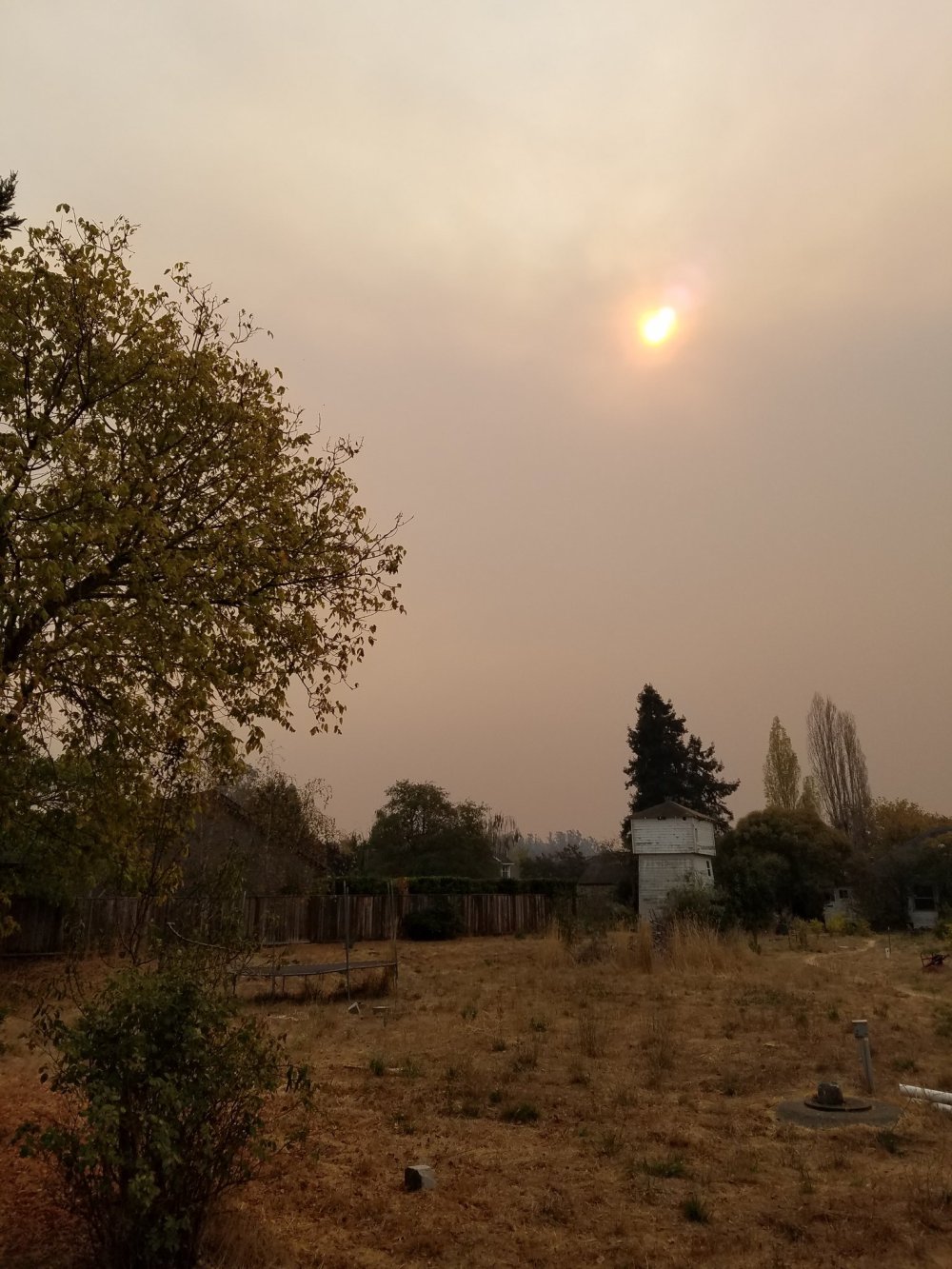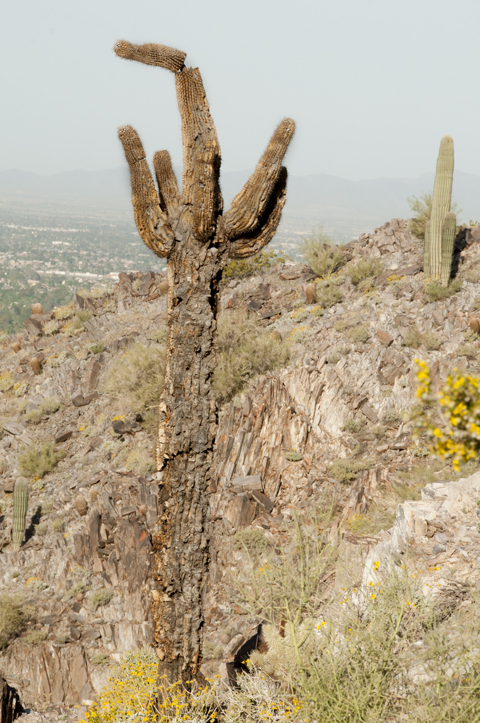Ever since Copernicus displaced Earth from its central position in the Universe, scientific investigations have progressively changed how humans have perceived the natural world.
Andrea Wulf’s book The Invention of Nature: Alexander Von Humboldt’s New World describes the life and work of Alexander Von Humboldt and how that work altered how we understand nature and our relationship to it.
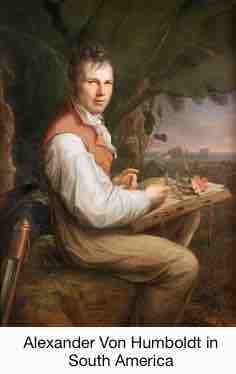 The book’s protagonist is Alexander Von Humboldt who was born in 1769 and who, over a life spanning eighty-nine years, was the participant in revolutions from the political, the American and French, to the biological triggered by Darwin’s 1859 book The Origin of Species.
The book’s protagonist is Alexander Von Humboldt who was born in 1769 and who, over a life spanning eighty-nine years, was the participant in revolutions from the political, the American and French, to the biological triggered by Darwin’s 1859 book The Origin of Species.
Humboldt’s great scientific accomplishment was his five year (1799-1804) exploration of the then unknown region including the Orinoco and Amazon rivers as well as the Andes Corderilla.
The scale of the expedition was tiny, just two scientists: Humboldt and the French botanist Aimé Bonpland. However, though small in scale, Humboldt ensured that its scientific capacity was state of the art for 1799, seeing that it was equipped with forty-one of the most up-to-date scientific instruments including: sextants, barometers, thermometers, magnetometers (to measure gravity), each device carefully packed in its velvet-lined protective case.
For five years the instruments accompanied Humboldt and Bonpland everywhere, whether in narrow native canoes, down rainforest trails, or up steep, narrow mountain trails as Humboldt and Bonpland collected, measured and noted everything they saw.
When they returned to Paris in 1804 (after visiting Philadelphia and Washington where they were welcomed by Thomas Jefferson), their baggage contained some 60,000 plant specimens that represented 2,000 previously unknown species as well as dozens of notebooks in which were recorded the measurements and records gathered during their more than 6,000 mile, five-year-long exploration.
Humboldt translated his notebooks into popular lectures as well as thirty-four books published French, German, English, Polish and Russian.
The “new world” of the book’s subtitle is Humboldt’s legacy for us, that we that we see
more deeply into nature including our role in it.
A new view means that there was an older way to see nature.
And there was: In the eighteenth century, an educated European or American was confident of two ideas about nature.
First, nature was degenerate. The Comte de Buffon, the director of the leading botanical institution of the day, made certain that everyone knew how degenerate it was: The primeval forest “an horrendous place full of decaying trees, rotting leaves, parasitic plants, stagnant pools and venomous insects.”
Improving nature meant taming nature. Wilderness would disappear to be related by orchards and plowed fields. ”Every acre tamed added to mankind’s profit.” (Wulf, p. 68)
Buffon’s perspective was from top down. The assumption that nature was “degenerate” leads the observer to find evidence that supports the assumption: rotting trees, venomous insects.
In contrast, Humboldt started at the bottom of things and worked upwards. What were the individual elements; the uncountable organisms large (the boa constrictor that could swallow a horse) to small (a hummingbird balanced on a delicate blossom) to the tiny (the line of ants moving across the forest floor), large, small, tiny caught in a web of relationships.
On the dry llano (plains) the Mauritia palms astonished Humboldt and Bonpland in the number of different organisms and phenomena that were linked to them. The tree’s fruits attracted monkeys and birds while its fronds mitigated the wind with the result that the wind-born dirt to fell to Earth to accumulate behind the palm trunks. The piled dirt sheltered by the palm trunks retained moisture and provided a place for insects and worms to shelter. (Wulf, p.85)
The network of relationships around the Mauritia palm was example of Humboldt’s “new world.” The new world was revealed by precise observation and careful measurement and then envisioned by an act of imagination that was constrained by fact, connotation, and probability. (Barzun, 1989)
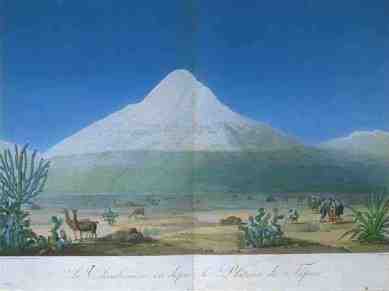 When Humboldt ascended Chimborazo, an extinct volcano, in the Andres, he and his party climbed higher than anyone had before. As they climbed upward, Humboldt observed how the types of plants changed with the altitude and he was reminded how he had seen the same kinds of plants when he had climbed in the Alps.
When Humboldt ascended Chimborazo, an extinct volcano, in the Andres, he and his party climbed higher than anyone had before. As they climbed upward, Humboldt observed how the types of plants changed with the altitude and he was reminded how he had seen the same kinds of plants when he had climbed in the Alps.
Certain plants grew in certain temperatures and light, attracting certain kinds of insects, drawing certain kinds of birds and animals.
Humboldt’s impressive memory and active imagination put it together.
“As he stood that day on Chimborazo, Humboldt absorbed what lay in front of him while his mind reached back to all the plants, rock formations and measurements that he had seen and taken on the slopes of the Alps, the Pyrenees…Everything he had observed fell into place. Nature, Humboldt realized, was a web of life and a global force.” (Wulf, p. 101.)
It was Humboldt’s new world that inspired the young Darwin before and during his voyage around the world on H.M.S. Beagle. As a student at Cambridge, Darwin recalled that Humboldt’s Personal Narrative “stirred up in him a burning zeal” to follow in Humboldt’s footsteps. He copied out passages and read them to his Cambridge botany teacher John Stevens Henslow. Of his fellow undergraduates, Darwin said that “I plague them with talking about tropical scenery.” (Wulf, 259)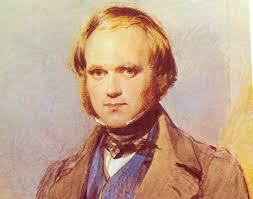
On the Beagle, his two guides were Humboldt’s Personal Narrative and Charles Lyell’s Geology. Wulf tells us that on the island of Santiago in the Cape Verde Islands, as he “rushed across Santiago, he saw the plants and animals through Humboldt’s eyes and the rocks through Lyell’s.” Later, back on board The Beagle he wrote a letter to his father “announcing that inspired by what he had seen on the island ‘I shall be able to do some original work in Natural History.’” (Wulf, p. 264)
Resources:
Barzun, Jacques (1991) “Of What Use the Classics Today?” From Begin Here: The Forgotten Conditions of Teaching and Learning. Chicago: The University of Chicago Press.
Portrait of Darwin retrieved from https://en.wikipedia.org/wiki/Portraits_of_Charles_Darwin
Image of Chimborazo retrieved from Retrieved from http://www.english.ucla.edu/faculty/wortham/Emerson%20The%20Poet/Chimborazo.htm
Wulf, Andrea (2015) The Invention of Nature: Alexander Von Humboldt’s New World. New York: Vintage Books.
Advertisements Share this:
